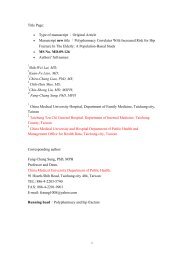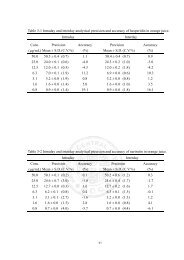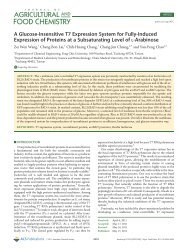Culinary Narratology in Everyday Life: Foodways and Identity ...
Culinary Narratology in Everyday Life: Foodways and Identity ...
Culinary Narratology in Everyday Life: Foodways and Identity ...
Create successful ePaper yourself
Turn your PDF publications into a flip-book with our unique Google optimized e-Paper software.
<strong>Cul<strong>in</strong>ary</strong> <strong>Narratology</strong> 21<br />
practice of cul<strong>in</strong>ary skills represents her “arts of existence” which are, <strong>in</strong> Foucault’s words,<br />
“those <strong>in</strong>tentional <strong>and</strong> voluntary actions by which men not only set themselves rules of<br />
conduct, but also seek to transform themselves, to change themselves <strong>in</strong> their s<strong>in</strong>gular be<strong>in</strong>g,<br />
<strong>and</strong> to make their life <strong>in</strong>to an oeuvre that carries certa<strong>in</strong> aesthetic values <strong>and</strong> meets certa<strong>in</strong><br />
stylistic criteria” (The Use of Pleasure 10-11). In cop<strong>in</strong>g with the dispossessed life <strong>in</strong><br />
diaspora, cookery has become an important way to ease Ashima’s sense of uprootedness <strong>and</strong><br />
to further re-build a certa<strong>in</strong> degree of self agency <strong>and</strong> autonomy.<br />
In the first half of the novel, Ashima is portrayed as typical immigrant woman who fears<br />
that her previous life will vanish <strong>and</strong> be replaced by “someth<strong>in</strong>g more complicated <strong>and</strong><br />
dem<strong>and</strong><strong>in</strong>g” (49-50). Hence, <strong>in</strong> the cultural aspects of everyday life, she privileges India<br />
over America, as demonstrated by her choices of wear<strong>in</strong>g traditional Indian sari <strong>and</strong><br />
preserv<strong>in</strong>g Bengali food recipes, despite all the <strong>in</strong>conveniences this entails (65). Dress <strong>and</strong><br />
food thus become salient cultural possessions that Ashima adheres to <strong>in</strong> her daily life <strong>in</strong> order<br />
to ma<strong>in</strong>ta<strong>in</strong> her familiar cultural identity. In the first half of her immigrant life <strong>in</strong> the US,<br />
Ashima, a faithful, submissive wife as well as a car<strong>in</strong>g mother, considers her husb<strong>and</strong> <strong>and</strong><br />
children’s <strong>in</strong>terests the most. After the births of Gogol <strong>and</strong> Sonia, children become<br />
Ashima’s second focus with regard to network<strong>in</strong>g with other Bengali immigrant families.<br />
Her son Gogol’s baptism, the “annaprasan, his rice ceremony” (38), is the first big event that<br />
br<strong>in</strong>gs other Bengali families <strong>in</strong>to Ashima’s circle. Though Ashima tries her best to<br />
replicate the authenticity of this important ritual, she still feels a sense of loss for she cannot<br />
help wish<strong>in</strong>g that her own sibl<strong>in</strong>gs <strong>and</strong> parents could be there to feed <strong>and</strong> bless her son (40).<br />
Initially as a newly arrived immigrant, Ashima perceives the US as a foreign country where<br />
her son Gogol’s birth “so alone, so deprived” (25) due to the absence of elder relatives’<br />
prayers <strong>and</strong> bless<strong>in</strong>gs for the new born baby. Therefore, the Bengali community serves as<br />
her only “acqua<strong>in</strong>tances” or “substitutes for the people who really ought to be surround<strong>in</strong>g<br />
them” (24), provid<strong>in</strong>g solace <strong>and</strong> support. Whenever a decision is to be made, Ashoke <strong>and</strong>









